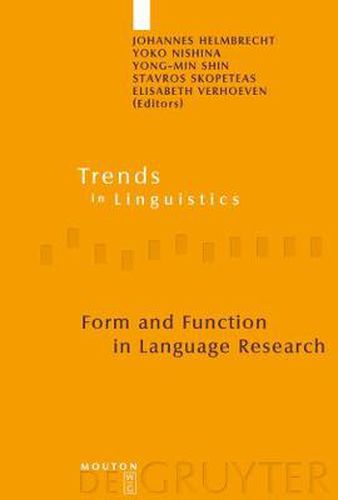Readings Newsletter
Become a Readings Member to make your shopping experience even easier.
Sign in or sign up for free!
You’re not far away from qualifying for FREE standard shipping within Australia
You’ve qualified for FREE standard shipping within Australia
The cart is loading…






This title is printed to order. This book may have been self-published. If so, we cannot guarantee the quality of the content. In the main most books will have gone through the editing process however some may not. We therefore suggest that you be aware of this before ordering this book. If in doubt check either the author or publisher’s details as we are unable to accept any returns unless they are faulty. Please contact us if you have any questions.
Language description enriches linguistic theory and linguistic theory sharpens language description. Based on evidence from the world’s languages, functional-typological linguistics has established a number of thorough generalizations about the nature of linguistic categorizations and their manifestation in natural languages. Empirical studies in these fields of linguistics have contributed to sharpen linguistic theory in several respects.
This volume is a collection of 19 contributions from outstanding scholars in the field of functional-typological linguistics that address fundamental issues in the study of language, such as the nature of linguistic categories, the constitution of functional domains, and the form of cross-linguistic continua. Empirical data from individual languages and from typological samples are investigated in order to achieve generalizations about the properties of human grammar(s). Several grammatical phenomena are dealt with including tonal systems, person distinctions, modalities, reciprocity, complex predicates, grammatical relations, word order, clause linkage, and information structure.
The structure of the book illustrates the fundamental importance of the analytical distinction between the onomasiological and the semasiological approach to language and language diversity. Both perspectives are integrated in most papers with a dominant focus on either the former or the latter perspective.
$9.00 standard shipping within Australia
FREE standard shipping within Australia for orders over $100.00
Express & International shipping calculated at checkout
This title is printed to order. This book may have been self-published. If so, we cannot guarantee the quality of the content. In the main most books will have gone through the editing process however some may not. We therefore suggest that you be aware of this before ordering this book. If in doubt check either the author or publisher’s details as we are unable to accept any returns unless they are faulty. Please contact us if you have any questions.
Language description enriches linguistic theory and linguistic theory sharpens language description. Based on evidence from the world’s languages, functional-typological linguistics has established a number of thorough generalizations about the nature of linguistic categorizations and their manifestation in natural languages. Empirical studies in these fields of linguistics have contributed to sharpen linguistic theory in several respects.
This volume is a collection of 19 contributions from outstanding scholars in the field of functional-typological linguistics that address fundamental issues in the study of language, such as the nature of linguistic categories, the constitution of functional domains, and the form of cross-linguistic continua. Empirical data from individual languages and from typological samples are investigated in order to achieve generalizations about the properties of human grammar(s). Several grammatical phenomena are dealt with including tonal systems, person distinctions, modalities, reciprocity, complex predicates, grammatical relations, word order, clause linkage, and information structure.
The structure of the book illustrates the fundamental importance of the analytical distinction between the onomasiological and the semasiological approach to language and language diversity. Both perspectives are integrated in most papers with a dominant focus on either the former or the latter perspective.